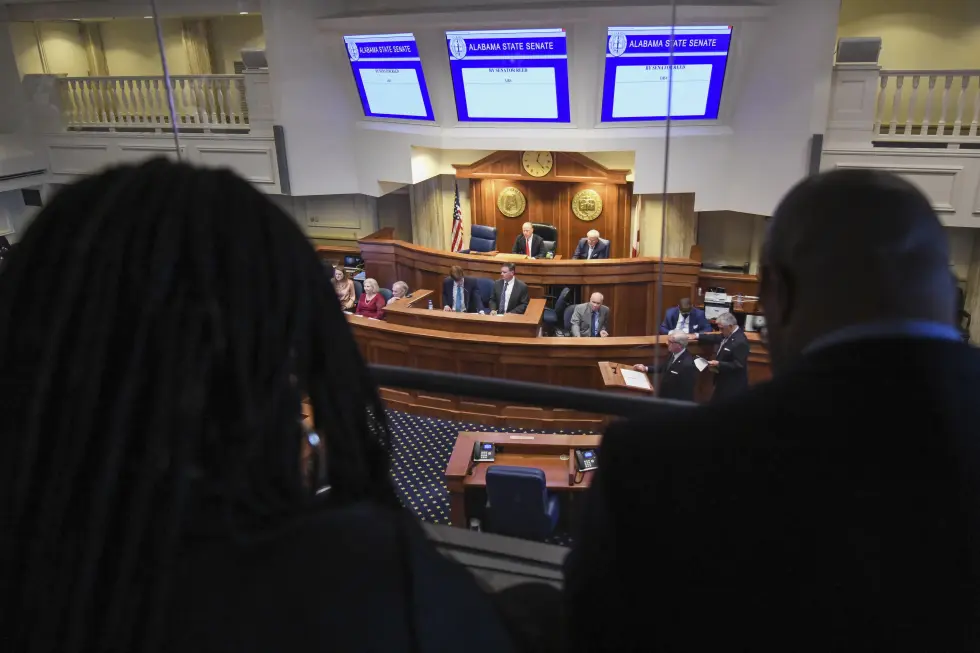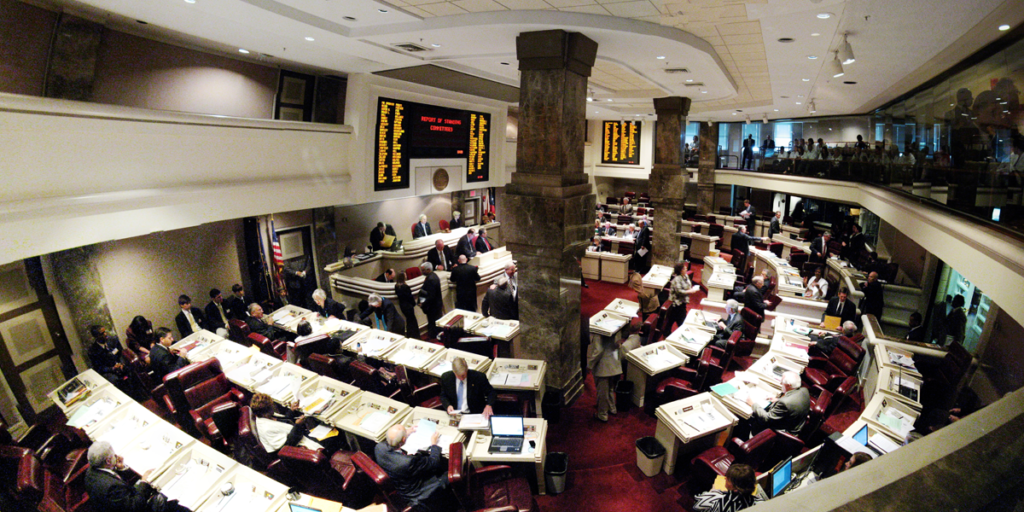Alabama lawmakers to negotiate construction of new Statehouse

Alabama lawmakers on Tuesday took another step toward construction of a new Alabama Statehouse by appointing a committee to negotiate a lease agreement. A 20-member panel that consists of legislative leaders and appointed members voted to allow a committee to negotiate a lease for a building that would be constructed by the Retirement Systems of Alabama. The panel will need to approve the lease agreement. Lawmakers in the last session approved legislation to contract with the Retirement Systems of Alabama, or another entity, for the construction of a Statehouse that would be leased back to the Legislature. The proposed new building would be located in a parking lot behind the existing Statehouse. The Retirement Systems has built several office buildings in downtown Montgomery that are used by other state entities. The negotiations are expected to be completed within a few weeks, members of the panel said. The current building is plagued by mold and other problems and lacks adequate space for the public to attend meetings, according to lawmakers. From the mid-1800s to 1985, Alabama lawmakers met at the Alabama Capitol, which also includes the governor’s office. Lawmakers in 1985 moved into the current building as a temporary meeting place when the Capitol was undergoing renovations. Lawmakers, who had offices in the new location, never moved back. Alabama lawmakers in 2020 briefly discussed the possibility of using $200 million of federal pandemic relief funds to build a new statehouse, but the idea drew immediate backlash. Republished with the permission of The Associated Press.
Alabama House okays proposed teacher retirement change

The bill would reverse some of the changes lawmakers implemented in 2013.
Alabama pension fund now sole owner of local newspaper chain

Alabama’s employee pension fund, with about 350,000 members and some $40 billion in managed assets, has become sole owner of one of the largest chains of local U.S. newspapers, the company said Thursday. CHNI LLC has been acquired by the Retirement Systems of Alabama, the company announced in a statement. The newspaper group includes 68 daily newspapers and more than 40 non-dailies plus websites in 22 states. The Montgomery, Alabama-based newspaper group is being spun off Raycom Media Inc., which is being purchased by the Atlanta-based Gray Television Inc. Raycom was owned by the retirement system. CNHI, which began as a small newspaper group in 1997 and previously operated with the state retirement system as its creditor, will gain stability through the acquisition, chief executive Donna Barrett said in the statement. “We are very excited about working with RSA again because of its dedication to the crucial role of newspapers in keeping the public informed on what is happening in their communities and beyond,” she said. Among CNHI’s newspapers are the Valdosta Daily Times in Georgia, The Tribune Star in Terre Haute, Indiana, the Gloucester Daily Times in Massachusetts, The Meridian Star in Mississippi and the Niagara Gazette in Niagara Falls, New York. Financial details weren’t announced. Alabama’s pension fund has other non-traditional investments including golf courses, airliners and the largest office building in New York City, 55 Water. Gray Television, which began as a regional broadcaster, owns or operates stations and digital properties in 91 television markets nationwide with the acquisition of Raycom Media. Republished with permission from the Associated Press.
Alabama state pension fund paying $370,000 in bonuses

Alabama’s state pension fund is paying a total of $370,000 in incentive bonuses to 14 employees. The bonuses were approved this month by board directors for the 2015 fiscal year. The head of the Retirement Systems of Alabama, David Bronner, says the bonuses help him keep strong employees in a competitive profession. The pension system earned a 1 percent return on its $32 billion in investments for the year that ended Sept. 30. That’s below its long-range target of 8 percent. But Bronner says the bonuses are based on performance relative to the markets, not the overall target. State Treasurer Young Boozer says the incentive program is “fair and reasonable.” A legislative committee is studying the state pension system and might recommend changes in 2016. Republished with permission of the Associated Press.
Daniel Sutter: Mickey Mantle, pensions and safety nets

Employer-provided pensions across the U.S. are changing. The old standard, the defined benefit plan, is rapidly disappearing. I suspect that this change will have significant consequences. Pensions typically take one of two forms, defined benefit and defined contributions. A defined benefit plan guarantees annual payouts in retirement, typically based on earnings and years worked, and employer contributions plus returns on investments pay these benefits. Under a defined contributions plan, employers contribute a specified amount to an employee account, and the accumulated contributions plus investment returns, however much this happens to be, is the employee’s retirement. The proportion of salaried, private sector employees covered by defined benefit plans fell from 38 percent in 1990 to 20 percent in 2008. Over this time, private sector workers with defined contribution plans increased from 8 percent to 31 percent. Most public sector employees currently have defined benefit plans, like the Retirement Systems of Alabama. But this is slowly changing; Michigan and Utah have switched new state employees to defined contribution plans. The form of the plan affects who bears pension risks. One risk is that contributions and investments will fail to yield sufficient funds for retirement. This could happen because of lower than expected investment returns, or because of mistakes in pension accounting, which is described as more of an art than a science. The potential also exists for someone to outlive their retirement funds. Employers bear these risks with defined benefit plans, versus employees with defined contribution plans. Both private and public sector defined benefit plans are often underfunded. Fewer than 10 percent of Standard & Poor’s 500 index firms with defined benefit plans, for instance, have fully funded pensions. Companies must make up the shortfall from an underfunded pension out of current revenues, which can drive an otherwise successful business into bankruptcy. Defined contribution plans avoid pension-induced bankruptcy, but result in people without funds for old age. As more companies and governments shift to defined contributions plans, this problem will only worsen. The life of baseball great Mickey Mantle illustrates the potential danger. I was in diapers when Mr. Mantle retired, but I learned early about his greatness as a player, and later about his famous carousing and drinking. Mr. Mantle often said that if he had known he was going to live so long (he died at age 63), he would have taken better care of himself. The progress and prosperity of our economy have supported modern medicine and a significant extension of life. Life expectation increased by 20 years between 1930 and 2010. Based on how economists estimate the value of years of life, living an extra 20 years is equivalent to a $2 million benefit for the typical American. I hope that progress in life extension continues, and even accelerates it if possible. We form expectations about life based on experience and available information. Mr. Mantle’s expectation was not unreasonable based on life when he was growing up in the 1930s. Before 1930, men did not on average to 60, and men in the Mantle family rarely saw 50. Many Americans never reached retirement age. Progress creates an imbalance between life plans based on yesterday’s world and a different, albeit better, future. For the lengthening of life, this imbalance takes the form of persons without funds for old age. Defined contribution pensions exacerbate this problem by placing the risk on people likely to make mistakes and possessing little ability to afford the consequences. Millions of persons without money for old age could lead to demands for a much expanded government safety net, perhaps an expanded Social Security designed to provide full retirement income. Ironically, defined benefit pensions provide a voluntary, contractual safety net. Pensions allow the sharing of risks involved in planning for old age. These pensions reduced the potential for people to save too little and voluntarily transferred wealth to those who live unexpectedly long lives. I do not know if defined benefit pensions will disappear. But if they disappear, I suspect that we will miss the market-based safety net they have provided for Americans as progress extended our life spans. Daniel Sutter is the Charles G. Koch Professor of Economics with the Manuel H. Johnson Center for Political Economy at Troy University and host of Econversations on TrojanVision. Respond to him at dsutter@troy.edu and like the Johnson Center on Facebook.
Robertson/Barth/Jahera: Legislators step up to tackle Alabama’s underfunded pensions

On November 9, a newspaper in North Alabama published an editorial suggesting that any legislative interest in our state’s public pension system would inevitably spell “disaster” for retirees. The editorial also claims that legislators may be plotting to “shore up” the General Fund through the “cash cow” of Alabama’s public pension system. In reality, a handful of Alabama legislators are undertaking the mammoth task of ensuring that our state can fulfill the obligations owed to current and future public retirees. This is no small task, as Alabama’s public pensions are underfunded by at least $15.2 billion. To put this number into perspective, every household in Alabama would need to contribute $8,274 to fully fund the system. To the casual observer, an unfunded pension liability is about as abstract a concept as the national debt. Many taxpayers may wonder why it even matters–will the bill ever really come due? Politicians in both cases often get away doing nothing, because they know that they won’t be around when the bill does come due to future generations. And every year that these problems aren’t dealt with, they worsen. Alabama’s public pensions, unlike most private sector pensions, are based on a defined benefit formula. This means that state employees pay into their retirement accounts, as do their state employers, and the Retirement Systems of Alabama (RSA) invests that money with a guaranteed return of 8%. Whether or not the investments actually return 8% matters little to state employees, who will receive the same contractual benefit no matter what. How is this possible? Because the Alabama Legislature-led by the same individuals now being wrongfully accused of trying to raid the pension system–has been faithfully paying a large sum of taxpayer dollars to RSA each year to cover its shortfalls. This year alone, legislators sent RSA nearly $1 billion. And they didn’t have to. The state is not legally required to pay the “annual required contribution” (known as the ARC), yet the legislature has never failed to make that payment–even when it has been painful to do so, as it was this year. The ARC is the yearly amount needed to fund current and future retirement benefits and liabilities. Why has the legislature made this payment? To keep the system solvent for our public retirees. Legislators in states like Illinois, New Jersey, and Pennsylvania chose not to fund the ARC, obligating taxpayers to further subsidize these drastically underfunded pensions. What Alabama’s legislators have begun to realize, however, is that it’s getting harder and harder to make that substantial annual payment to RSA, especially with no end in sight (it’s expected to increase by 3.4% this year). The legislature’s pension study committee, led by Senator Arthur Orr and Representative Lynn Greer, is taking this concern seriously. The reforms that the committee is contemplating will have no impact on the benefits of any current retiree or state employee; however, these changes would aid in protecting the retirement that these individuals have already earned. To do so, the rise of our unfunded liability (which has increased by an astounding 625% since 2003) must be halted. The defined benefit plan exposes the State of Alabama (the employer) to the maximum risk of future funding shortfalls. As long as we continue to add new employees to this plan, we risk going even deeper into pension debt. To avoid this situation, the legislative study committee is looking at pension options for future employees that would reduce the state’s long-term risk of pension underfunding and allow Alabama to pay down its current pension debt. It’s a painstaking task, but one that could have a sizable and lasting payoff for state employees and taxpayers alike. Over the years, a number of state leaders have tried but failed to accomplish pension reform for many of the same reasons that congressmen have given up on fighting debt limit increases. For instance, there’s a great deal of misinformation surrounding the debate that heavily clouds the merits and necessity of reform. Some will argue that the $15 billion pension debt isn’t even problematic. The general public is largely apathetic to the plight of state employees, who have better retirement benefits than many Alabamians, and state employees are led to believe that reform efforts signal that someone is after their retirement. In spite of these troubling realities, a few key legislators have decided to roll up their sleeves and attempt to deal with this critical issue. They should be applauded–by state employees, for working to safeguard their retirement funds; by their colleagues, for taking on a weighty assignment that nobody else wanted; and by taxpayers, who may not care much about public pensions, but have been and will continue to be called upon to “shore up” Alabama’s retirement system unless reforms are made. Katherine Green Robertson serves as Vice President of the Alabama Policy Institute. Dr. James R. Barth is the Lowder Eminent Scholar of Finance and Dr. John S. Jahera is the Lowder Professor of Finance at Auburn University.


